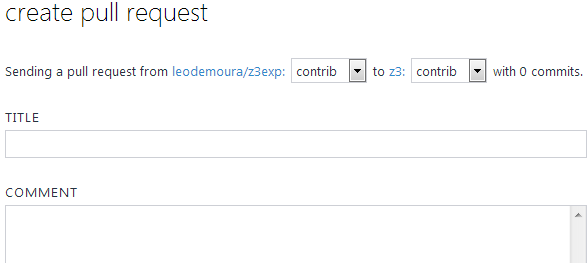
External contributions
Today, we started to accept external contributions to the Z3 code base. First, I’d like to emphasize that Z3 does not have a liberal license such as GPL or Apache. The source code is available, but it cannot be used for commercial purposes. Moreover, if we read the license carefully, item 3 says that Microsoft can use external contributions for commercial purposes. It is understandable that some may think this is a unfair clause. If you do not agree with the license terms, please do not contribute any code.
We initially did not want to accept external contributions. The main issue was that some Z3 internal users have strict
rules against external contributions. They can only use code bases that were implemented by Microsoft employees and/or contractors.
However, as we gained experience with git, it became clear that we can easily maintain a pure branch
containing only internal contributions, and the master branch with internal and external contributions.
Now, the 4 main branches in the Z3 project are
masterthe official branch containing internal and external contributions.purethe official branch for internal users that cannot use external contributions.unstablethe branch for working in progress being done by the Z3 team.contribthe branch for new external contributions and new changes fromunstable.
Remark: We also have other branches for experimental features we are working on.
Our plan is to use the following work-flow. The Z3 team works on the unstable branch. When the code in the unstable branch becomes “stable”,
it is merged into the pure branch. External contributors submit “pull requests” to the contrib branch. When the changes in pure and contrib are stable, they are merged into the master branch.
The Z3 code base is big and not very well documented. So, it is hard to make contributions to the main engines. At this point, it is more realistic to target contributions such as
- Bindings for other programming languages (e.g., Java).
- New functionality on top of the existing API (e.g., maxsat, allsat, etc).
- New examples using the Z3 API.
- Regression tests
In future blog posts, I’m planning to describe the main data-structures used in Z3, and how to add more complicated functionality.
I suggest anybody interested in submitting code to contact a Z3 team member before investing time working on it.
The idea is to coordinate where the contribution will fit in the project, the scope, and how it will integrate with the other components.
Important: Please, do not submit bug fixes using pull requests. Instead submit a bug report using the issue tracker. Feel free to describe a potential fix.
Here are some instructions on how to fork, modify and submit your modifications to the Z3 project.
-
Make sure you have git installed in your system.
-
Fork the Z3 code base. You just have to click the Fork link as described below.

- Name your fork. In the following example, I used the name
z3exp.

- Retrieve your fork using
git. In the following command, the option-b contribis used to retrieve thecontribbranch. Note that you have to replaceleodemourawith your username, andz3expwith the name you used for your Fork.
git clone https://git01.codeplex.com/forks/leodemoura/z3exp -b contribRemark: CodePlex requires git 1.7.10 or later to avoid HTTPS cloning errors. If you are using an older version of git, you might get an error. If that is your case, here are some instructions on how to fix it.
- Perform your modifications and commit them and submit to codeplex. This is your Fork. You can make changes locally and save them at codeplex.
... modify/create files ...
git commit -a -s -m "my modifications"
git push- After you implemented and tested your contribution, you can submit a pull request to the Z3 code base.

You are essentially submitting your changes in the contrib branch (in your Fork) to the contrib branch in the Z3 code base.
You have to make sure that the from and to branches are selected correctly like in the following example.

